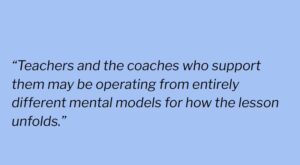03.04.24Lesson Delivery Models and Lesson Prep

In our previous three posts, we described lessons learned from our partnership with Harmony Public Schools as they endeavored to strengthen a culture of Lesson Preparation across their 60 campuses.
Our team defines Lesson Preparation as consisting of 3 core practices:
- Plan the Exemplar
- Plan for Error
- Plan the Means of Participation
(For more on these core practices, check out previous TLAC posts on Lesson Prep here and here).
We think the three practices can be flexibly and productively applied across all grades and content areas. However, to realize the full potential of Lesson Preparation, school systems need to provide teachers and leaders with examples of the three practices embedded within a Lesson Delivery Model – a clear, content-specific vision for the instructional sequence of a typical lesson.
Lesson Delivery Models Defined
We define a Lesson Delivery Model (LDM) as a guidance document that explicitly names the vision for how a lesson in a specific content area unfolds from start to finish. Unlike the core practices of Lesson Preparation, LDMs need to be content specific because how a strong math lesson unfolds is not the same as how a literature lesson or a biology inquiry lab unfolds. LDMs make explicit the student and teacher actions that, when prepped effectively via Lesson Preparation, allow students to experience rigorous, engaging, and responsive lessons.
As part of our work with Harmony we worked with the Curriculum Directors of Harmony’s Curriculum Department to support them in defining how lessons should unfold in their respective content areas–and then codify it in a Lesson Delivery Model.
An Example LDM
One of the leaders we worked with closely is Elvia Rimer, Curriculum Director for Literacy, K-2. In the Spring of 2022, Elvia created a K-2 ELA-R Lesson Delivery Model that outlined how a K-2 literacy block should unfold. Her LDM articulated:
- Core components of the literacy block with critical pacing notes
- The purpose behind each component for student learning
- Key teacher and student actions that should be observed within each component
For Professional Development support, Elvia prioritized phonics instruction as the focus area to ensure more students within Harmony were finishing the year on or above grade-level. Working from the defined LDM, Elvia was able to live model in PD the phonics routine from start to finish so that teachers and leaders could experience the LDM they’d begun to process on paper.
With a clear understanding of the flow of a Phonemic Awareness and Phonics lesson in mind, Elvia then led teachers and leaders to analyze the lesson preparation she engaged in to support her model lesson. Teachers could then understand (via example) how Plan the Exemplar, Plan for Error, and Plan for Means of Participation worked together to support the execution of a strong Phonics lesson.
The clarity of the Phonics LDM led Harmony’s students to experience more success in the ‘22-’23 school year. Harmony’s K-2 literacy data:
- Increased the number of students reading on or above grade level by 18% from Beginning of the Year (BOY) to End of the Year (EOY)
- Decreased the number of students needing Tier 3 support by 13%
Our work with Elvia along with other Harmony Curriculum Directors (Tiffany Ekarius, Elementary Math Director, Ismail Savruk, Secondary Math Director, Farjana Yasmin, Biology Director) provided us one of the key learnings we had in the second year of our partnership: Teachers need to see strong content and curriculum specific examples of Lesson Preparation in order to link preparation to execution effectively.
LDMs Make Lesson Preparation More Effective
Why are Lesson Delivery Models critical in the context of lesson preparation? In the absence of a Lesson Delivery Model, teachers and the coaches who support them may be operating from entirely different mental models for how the lesson unfolds–or the experienced coach may be working from a mental model of much higher clarity and precision.
In some of the early Lesson Prep coaching we observed, coaches and teachers engaged earnestly in preparing the exemplar, planning for error, and planning the means of participation but it didn’t translate into an engaging lesson that ensured success for all students. Why? The teacher didn’t have a clear understanding for how the work they had just done fit into a larger vision of instruction in their content area. Additionally, teachers and coaches, without realizing it, may be operating from different definitions of what constitutes a “successful lesson.” Situating a collaborative study of Plan the Exemplar within the defined sequence of a LDM ensures that teachers and coaches are working towards a shared understanding of success.
To return to the final lesson we named at the outset of this series: A single year of training investment does not move a system to mastery. Harmony is sustaining a multi-year commitment to internal capacity building at all levels of their organization. That level of commitment is often rare, and for us, inspiring. We are deeply grateful to Harmony Public Schools for allowing us to contribute and be partners on their journey.